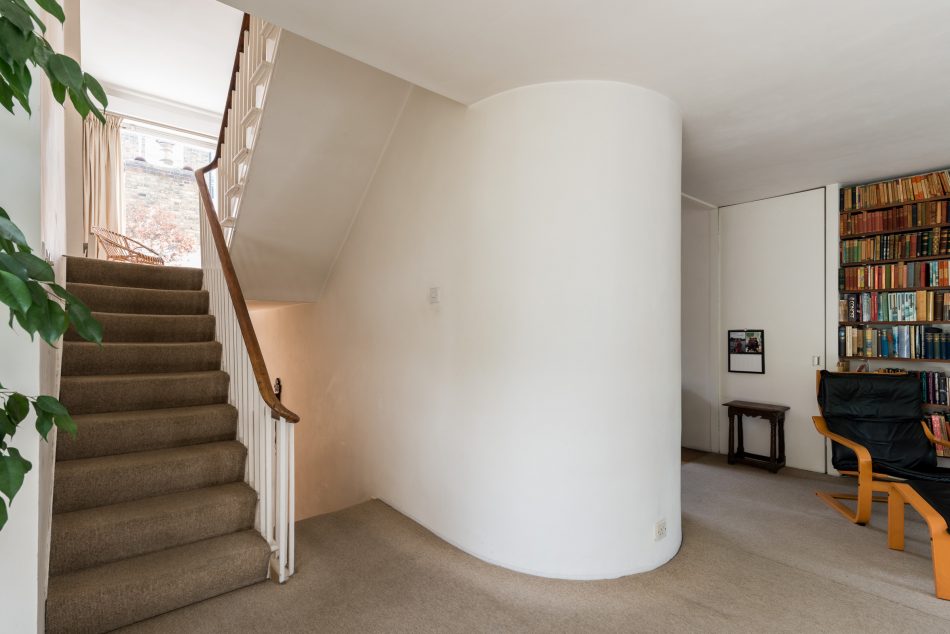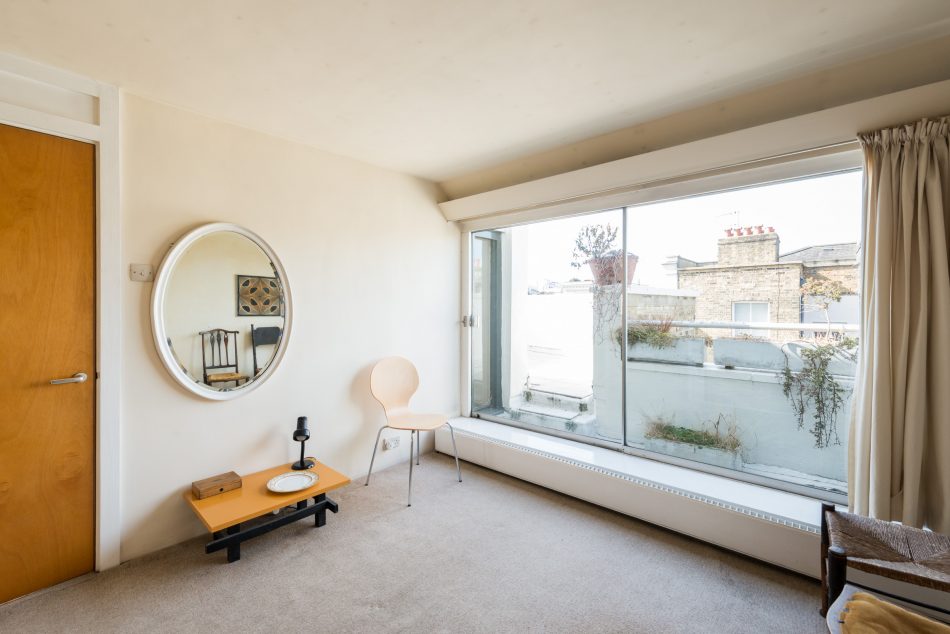

























Winchester Street
London SW1
Architect: Stout & Litchfield
Register for similar homesQuietly located at the end of a mid-Victorian terrace in Pimlico, this wonderfully engaging four-bedroom upper maisonette was converted by the modernist architects Stout & Litchfield in 1970. It offers more than 2,000 sq ft of internal accommodation over several levels, with open-plan spaces and huge amounts of natural light.
The property combines Victorian grandeur with elegant modern detailing. It is being offered for sale for the first time in almost 50 years, and requires complete refurbishment. The sale price for the apartment includes the freehold for the building.
The property has its own entrance to the side of the building. It opens onto an entrance hall with hanging space for coats, and then stairs to the first floor. There is a kitchen and dining room at the rear, with the original 1970s fittings. This leads in turn to a fantastic reception room and open study area, with excellent ceiling height and large windows on three sides. Two huge Victorian sashes at the front overlook a mature tree on Winchester Street.
There is a large roof terrace off the landing, and then stairs up to the second floor, which contains two double bedrooms with built-in wardrobes, and a separate bathroom. Up another half level is a study or single bedroom. The top floor contains two large rooms linked together by a full-height door; these could be used as separate bedrooms, or as a master bedroom and dressing room. One has an en-suite bathroom, and the other has glazed sliding aluminium doors onto another terrace.
Winchester Street is quietly positioned within the attractive ‘Pimlico Grid’. There are outstanding transport links within close proximity: the Underground is available at Pimlico (Victoria Line) and Sloane Square (Circle and District Lines), and Victoria station offers mainline rail services including direct trains to Gatwick Airport. The property is within easy reach of Battersea Park, as well as the shops and restaurants of Victoria, Chelsea and Belgravia.
Please note that all areas, measurements and distances given in these particulars are approximate and rounded. The text, photographs and floor plans are for general guidance only. The Modern House has not tested any services, appliances or specific fittings — prospective purchasers are advised to inspect the property themselves. All fixtures, fittings and furniture not specifically itemised within these particulars are deemed removable by the vendor.




History
Numbers 50 and 50a Winchester Street are a pair of maisonettes converted from a mid-Victorian house by the architects Roy Stout and Patrick Litchfield, for their own use. What attracted them to the building was the fact that it was a corner house with a side entrance, giving it a front room on the ground floor that did not have the usual entrance passage cut out of it. It also had an area at basement level which continued around the corner on Clarendon Street and which gave access to no less than eight vaulted cellars.
Stout and Litchfield lived in the building with their families, and they also ran their architecture practice from a home-office at the front.
The project was featured in the Architectural Review shortly after its completion in 1970. The following is an excerpt from the magazine:
“The conversion entailed the division of the house into two maisonettes – the ground floor and basement for Patrick Litchfield, and the upper three floors for Roy Stout and his family. Because of the side street it was possible to give each maisonette its own entrance… The mansard was rebuilt with straight walls, and the back extension was raised one floor. The usual cross-wall between the front and back room was replaced by steel beams to open up the living floors and provide complete freedom in the planning of bedrooms and bathrooms.
“The upper maisonette is a series of half levels. The top floor with its sitting room and roof terrace is the parents’ floor, though the sitting room can be closed off for guests. The next half level is a child’s bedroom over part of the back extension. Then comes the main children’s floor over the front part, followed by another roof terrace over the back part. The main living area lies under the children’s floor and is open to the staircase so that one can look up towards the roof terrace or down into the kitchen-dining area.
“The lower maisonette includes a studio on the ground floor and an open living area in a dramatically transformed basement where all the available space has been used to brilliant effect. Large full-height windows reveal the vaults, now painted white and turned into a sort of arcaded garden that becomes the real enclosure of the living room, especially when lit up at night. The rectangular space of the interior is broken up by a diagonal layout of furniture fittings, and by the thin inner wall which is splayed at window reveals to the same 45-degree angle. A low slatted ceiling emphasises the horizontal distances and defines the main volume of the room. A sense of spaciousness and continuity has been achieved throughout both maisonettes by the consistent use of few materials. Thus all the walls are white, and lowered ceilings, which unite spaces that would otherwise be split up by beams or changes of level, are a light olive-green. The basement floor is heather-brown quarry tiles but all upper floors are carpeted in a dark khaki haircord. Joinery fittings in all kitchens and bathrooms are made from iroko and black plastic laminate.”


























